spark LOTUS ELISE 2005 Owners Manual
[x] Cancel search | Manufacturer: LOTUS, Model Year: 2005, Model line: ELISE, Model: LOTUS ELISE 2005Pages: 205, PDF Size: 4.51 MB
Page 6 of 205
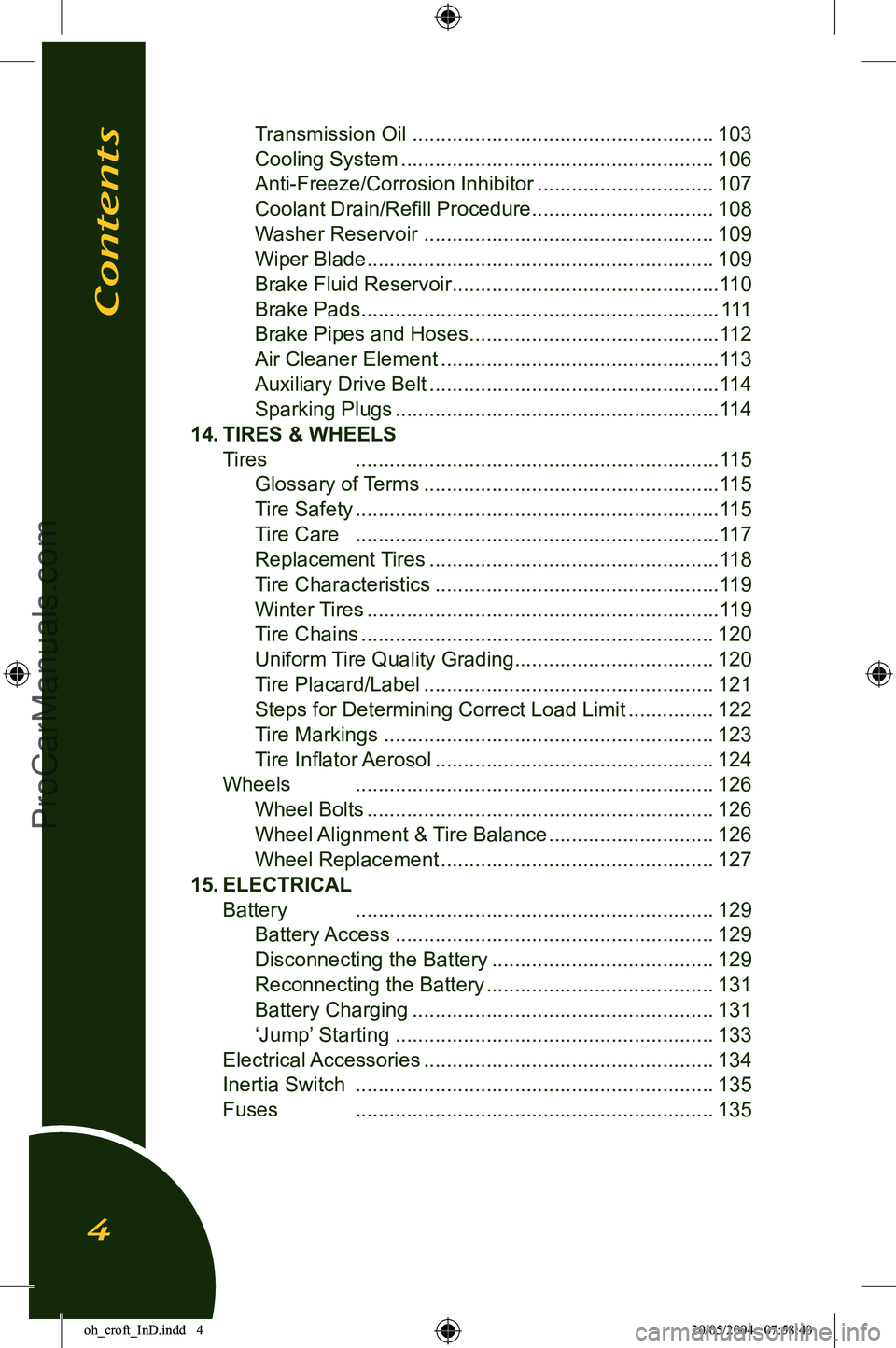
Transmission Oil .....................................................103
Cooling System .......................................................
106
Anti-Freeze/Corrosion Inhibitor ...............................
107
Coolant Drain/Refill Procedure ................................
108
Washer Reservoir ...................................................
109
Wiper Blade .............................................................
109
Brake Fluid Reservoir ............................................... 110
Brake Pads ............................................................... 111
Brake Pipes and Hoses ............................................112
Air Cleaner Element ................................................. 113
Auxiliary Drive Belt ................................................... 114
Sparking Plugs ......................................................... 114
14. TIRES & WHEE
LS
Tires ................................................................ 115
Glossary of Terms .................................................... 115
T
ire Safety ................................................................ 115
Tire Care ................................................................ 117
Replacement Tires ................................................... 118
Tire Characteristics .................................................. 119
Winter T
ires .............................................................. 119
Tire Cha
ins ..............................................................120
Uniform T
ire Quality Grading ...................................120
Tire Placard
/Label ...................................................121
Steps
for Determining Correct Load Limit ...............122
Tire Ma
rkings ..........................................................123
T ire Inflator Aerosol .................................................
124
Wheels ...............................................................
126
Wheel Bolts .............................................................
126
Wheel Alignment & Tire Balance .............................
126
Wheel Replacement ................................................
127
15. ELECTRICAL
Battery ...............................................................129
Battery Access ........................................................
129
Disconnecting the Battery .......................................
129
Reconnecting the Battery ........................................
131
Battery Charging .....................................................
131
‘Jump’ Starting ........................................................
133
Electrical Accessories ...................................................
134
Inertia Switch ...............................................................
135
Fuses ...............................................................
135
Contents
4
oh_croft_InD.indd 420/05/2004 07:58:40ProCarManuals.com
Page 15 of 205
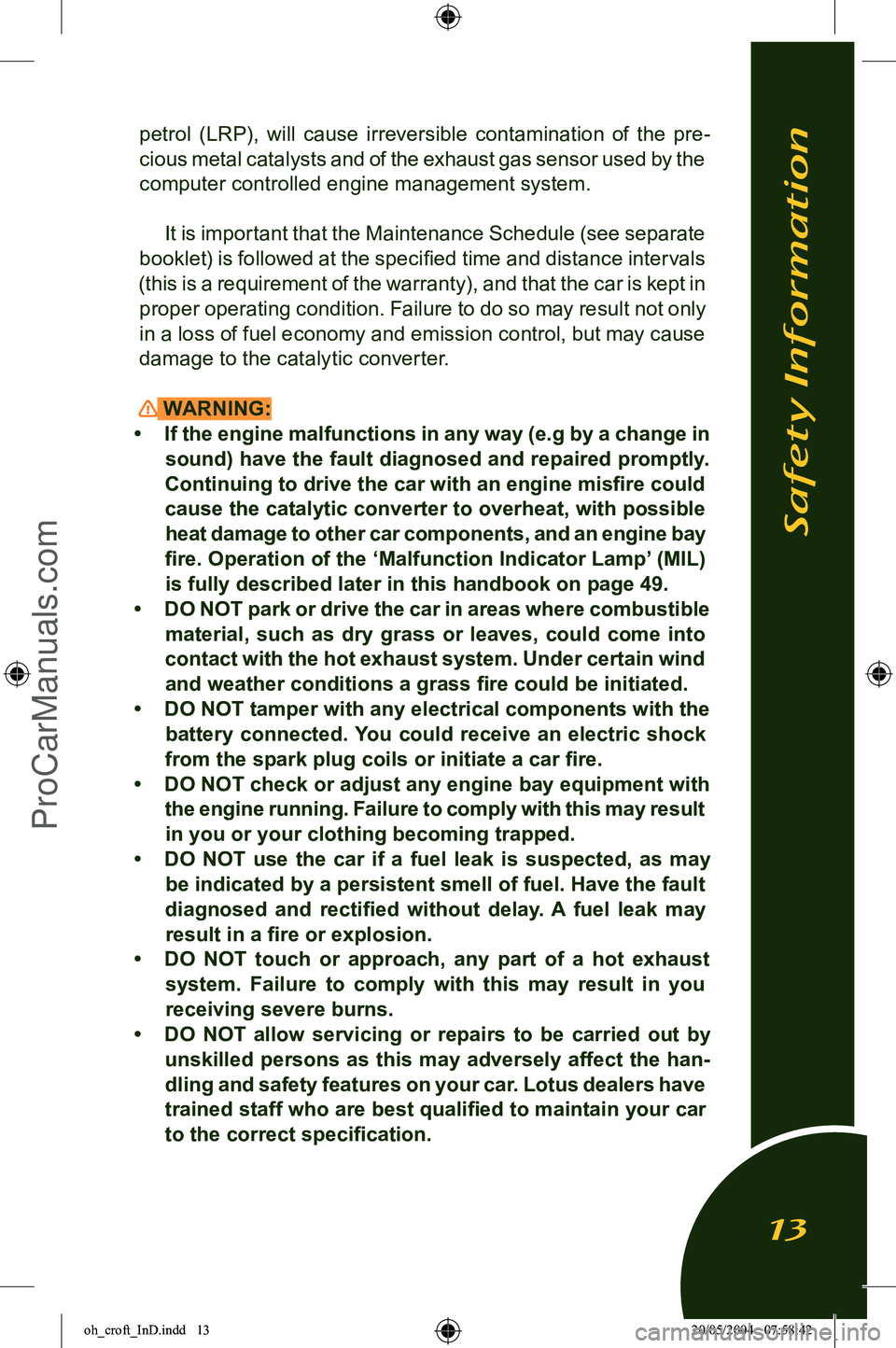
petrol (LRP), will cause irreversible contamination of the pre-
cious metal catalysts and of the exhaust gas sensor used by the
computer controlled engine management system.
It is important that the Maintenance Schedule (see separate
booklet) is followed at the specified time and distance intervals
(this is a requirement of the warranty), and that the car is kept in proper operating condition. Failure to do so may result not only
in a loss of fuel economy and emission control, but may cause damage to the catalytic converter.
WARNING:
• If the engine malfunctions in any way (e.g by a change in sound) have the fault diagnosed and repaired promptly.
Continuing to drive the car with an engine misfire could cause the catalytic converter to overheat, with possible heat damage to other car components, and an engine bay
fire. Operation of the ‘Malfunction Indicator Lamp’ (MIL)
is fully described later in this handbook on page 49.
• DO NOT park or drive the car in areas where combustible material, such as dry grass or leaves, could come into
contact with the hot exhaust system. Under certain wind and weather conditions a grass fire could be initiated.
• DO NOT tamper with any electrical components with the battery connected. You could receive an electric shock
from the spark plug coils or initiate a car fire.
• DO NOT check or adjust any engine bay equipment with the engine running. Failure to comply with this may result
in you or your clothing becoming trapped.
• DO NOT use the car if a fuel leak is suspected, as may be indicated by a persistent smell of fuel. Have the fault
diagnosed and rectified without delay. A fuel leak may result in a fire or explosion.
• DO NOT touch or approach, any part of a hot exhaust
system. Failure to comply with this may result in you
receiving severe burns.
• DO NOT allow servicing or repairs to be carried out by unskilled persons as this may adversely affect the han
-
dling and safety features on your car. Lotus dealers have
trained staff who are best qualified to maintain your car
to the correct specification.
Safety Information
13
oh_croft_InD.indd 1320/05/2004 07:58:42ProCarManuals.com
Page 116 of 205
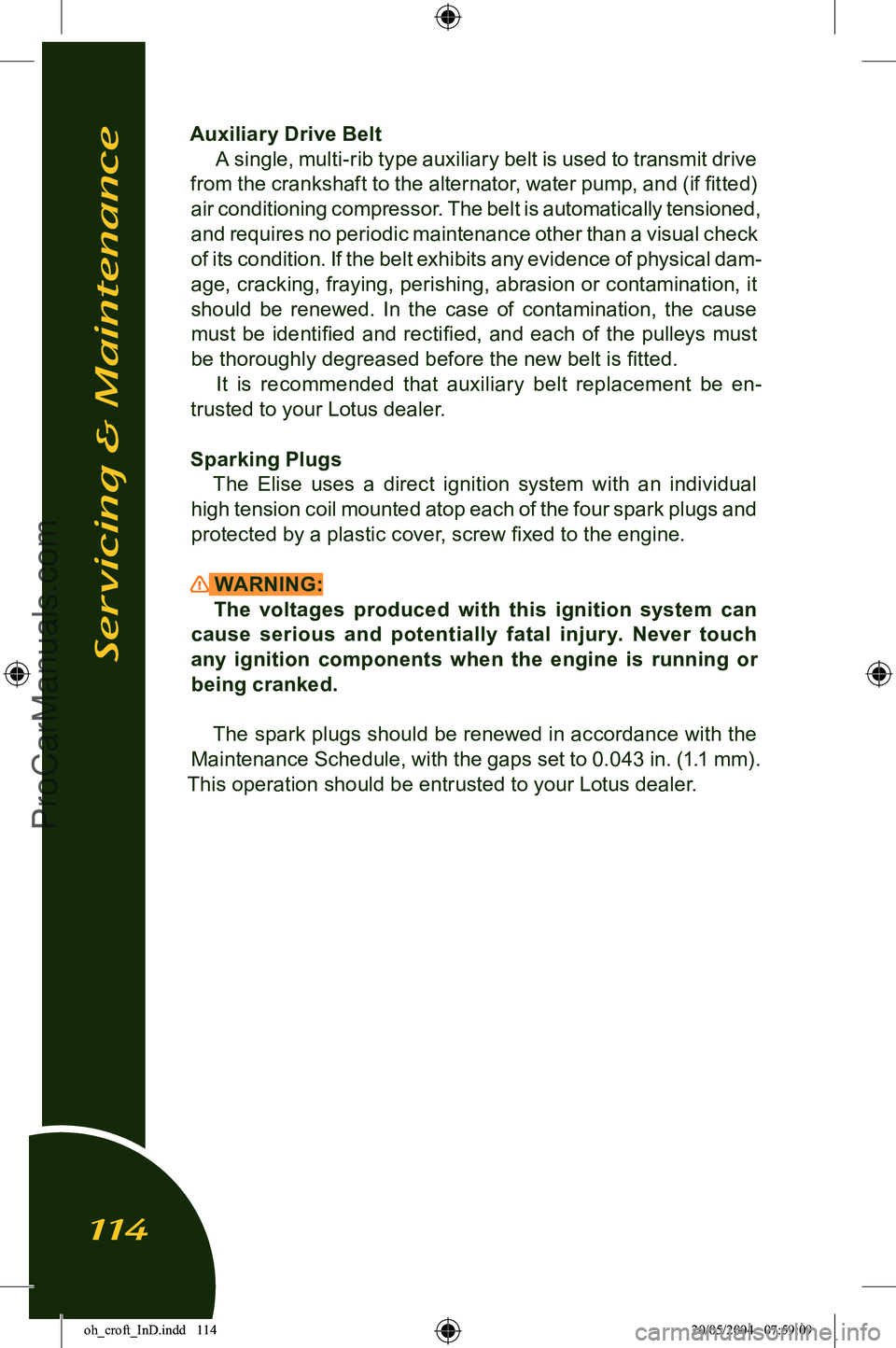
Auxiliary Drive BeltA single, multi-rib type auxiliary belt is used to transmit drive
from the crankshaft to the alternator, water pump, and (if fitted)
air conditioning compressor. The belt is automatically tensioned,
and requires no periodic maintenance other than a visual check of its condition. If the belt exhibits any evidence of physical dam
-
age, cracking, fraying, perishing, abrasion or contamination, it
should be renewed. In the case of contamination, the cause
must be identified and rectified, and each of the pulleys must be thoroughly degreased before the new belt is fitted. It is recommended that auxiliary belt replacement be en
-
trusted to your Lotus dealer.
Sparking Plugs The Elise uses a direct ignition system with an individual
high tension coil mounted atop each of the four spark plugs and protected by a plastic cover, screw fixed to the engine.
WARNING: The voltages produced with this ignition system can
cause serious and potentially fatal injur y. Never touch
any ignition components when the engine is running or being cranked.
The spark plugs should be renewed in accordance with the
Maintenance Schedule, with the gaps set to 0.043 in. (1.1 mm).
This operation should be entrusted to your Lotus dealer.
Servicing & Maintenance
114
oh_croft_InD.indd 11420/05/2004 07:59:09ProCarManuals.com
Page 131 of 205
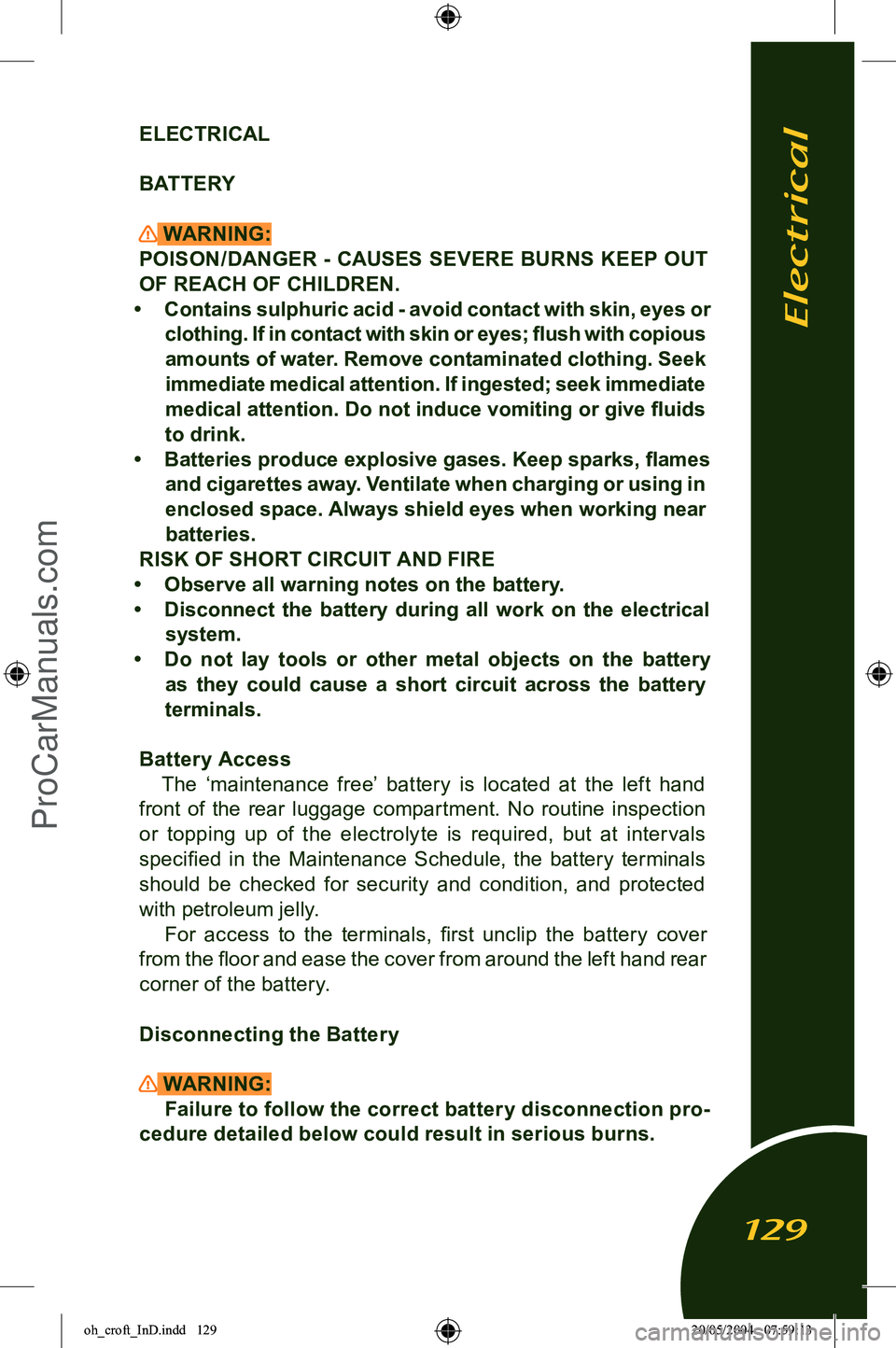
ELECTRICAL
BATTERY
WARNING:
POISON/DANGER - CAUSES SEVERE BURNS KEEP OUT
OF REACH OF CHILDREN.
• Contains sulphuric acid - avoid contact with skin, eyes or clothing. If in contact with skin or eyes; flush with copious amounts of water. Remove contaminated clothing. Seek
immediate medical attention. If ingested; seek immediate
medical attention. Do not induce vomiting or give fluids
to drink.
• Batteries produce explosive gases. Keep sparks, flames and cigarettes away. Ventilate when charging or using in
enclosed space. Always shield eyes when working near
batteries.
RISK OF SHORT CIRCUIT AND FIRE
• Observe all warning notes on the battery.
• Disconnect the battery during all work on the electrical system.
• Do not lay tools or other metal objects on the battery as they could cause a short circuit across the battery
terminals.
Battery Access The ‘maintenance free’ battery is located at the left hand
front of the rear luggage compartment. No routine inspection or topping up of the electrolyte is required, but at inter vals
specified in the Maintenance Schedule, the battery terminals
should be checked for security and condition, and protected
with petroleum jelly. For access to the terminals, first unclip the battery cover
from the floor and ease the cover from around the left hand rear corner of the battery.
Disconnecting the Battery
WARNING: Failure to follow the correct battery disconnection pro
-
cedure detailed below could result in serious burns.
Electrical
129
oh_croft_InD.indd 12920/05/2004 07:59:13ProCarManuals.com
Page 132 of 205
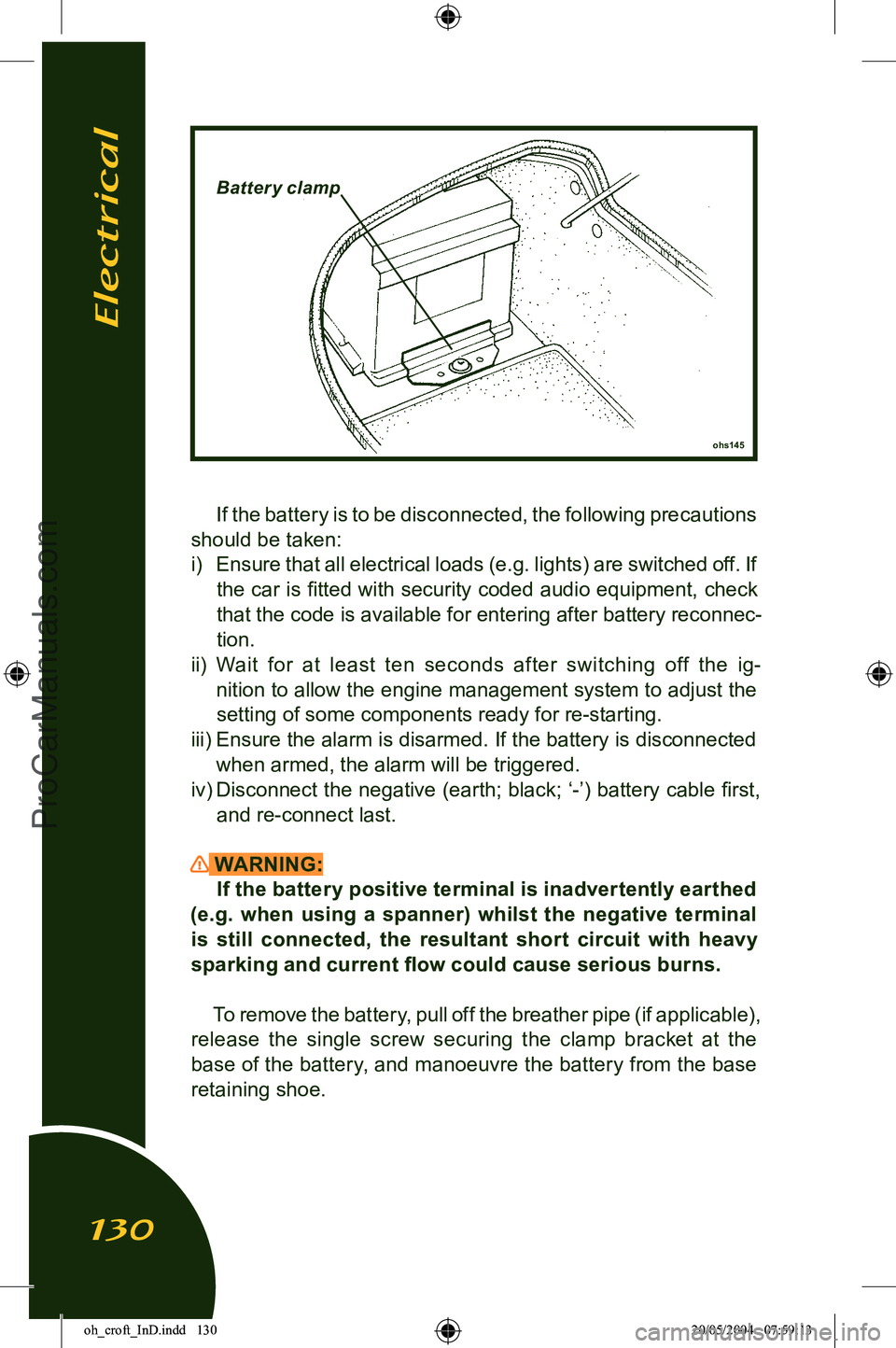
If the battery is to be disconnected, the following precautions
should be taken: i) Ensure that all electrical loads (e.g. lights) are switched off. If
the car is fitted with security coded audio equipment, check
that the code is available for entering after battery reconnec
-
tion.
ii) Wait for at least ten seconds after switching off the ig-
nition to allow the engine management system to adjust the
setting of some components ready for re-starting.
iii) Ensure the alarm is disarmed. If the battery is disconnected
when armed, the alarm will be triggered.
iv) Disconnect the
negative (earth; black; ‘-’) battery cable first,
and re-connect last.
WARNING:
If the battery positive terminal is inadvertently earthed
(e.g. when using a spanner) whilst the negative terminal
is still connected, the resultant short circuit with heavy sparking and current flow could cause serious burns.
To remove the battery, pull off the breather pipe (if applicable),
release the single screw securing the clamp bracket at the
base of the battery, and manoeuvre the battery from the base
retaining shoe.
ohs145
Batter y clamp
Electrical
130
oh_croft_InD.indd 13020/05/2004 07:59:13ProCarManuals.com
Page 135 of 205

‘Jump’ StartingIf the battery becomes discharged to the extent that the en
-
gine cannot be started, proprietary good quality ‘jumper cables’ may be used to connect with the battery of a second car in order
to provide the energy necessary for starting.
WARNING: It is most important that the correct procedure is fol
-
lowed in order to avoid damage to either car’s electrical system, and most importantly, to minimise the danger of a
spark induced battery explosion. Check that the slave car
also has a NEGATIVE EARTH electrical system.
i) With the engine of the slave car running at a fast idle, use one jumper cable (red) to connect the positive (+) terminal of
one battery to the positive terminal of the other battery. Take
care during this process to avoid inadvertently earthing a free end of this cable to the metal body or chassis of either car.
ii) Connect one end of the other jumper cable (black) to the negative (-) terminal of the discharged battery.
iii) A spark will occur when the other end of this cable (the final connection) is connected to an earth on the slave car. This
connection should therefore be made to a point away from
the battery, and away from any fuel vapour area or moving
parts. An engine hanger bracket is often ideal.
iv) Start the car in the usual way, and run at a fast idle.
ohs14c
JUMP STARTING
Electrical
133
oh_croft_InD.indd 13320/05/2004 07:59:14ProCarManuals.com
Page 136 of 205

v) A spark will occur at the first disconnection of a jumper cable, so it is essential that the first disconnection is made from the
slave car earth. Both batteries (especially the
discharged one) will be ‘gassing’ heavily at this time, and if the first disconnection is made at a battery terminal, there is
a danger that the hydrogen gas may be ignited by the spark
with a resultant explosion.
vi) Have the cause of the flat battery investigated and rectified,
and trickle charge the battery as detailed above.
WARNING:
• Risk of damage and serious personal injury due to
shortcircuit.
• Use only jumper cables of adequate cross-section, fitted
with completely insulated alligator clamps. The cables must be long enough to allow that neither cars nor cables
touch each other.
• Follow all warnings and instructions of the jumper cable
manufacturer.
• When connnecting the jumper cables, keep them away
from engine moving parts.
• The two cars must not contact each other, or current could flow as soon as the positive terminals are connected.
• When the first clamp on each cable is connected, the other clamp on that cable must be held carefully to make sure it does not come into contact with either another cable
clamp or either car.
• Ensure that tools or metal watches or jewellery do not contact the battery terminals or live car parts.
NOTICE:
• Improper jumper cable connection can damage the alternator
and other electrical components.
• Do not attempt to push or tow start the car, as damage to the
catalytic converter or other parts could be caused.
Electrical Accessories Owners should note that the only approved extras and modi
-
fications are those which are specified by Lotus and carried out by Lotus or by an authorised dealer. Neither Lotus Cars Ltd. or
Lotus Cars Inc. accept any liability whatsoever for defects which arise from extras or modifications which are not approved by
Lotus Cars Ltd.
Electrical
134
oh_croft_InD.indd 13420/05/2004 07:59:14ProCarManuals.com
Page 161 of 205
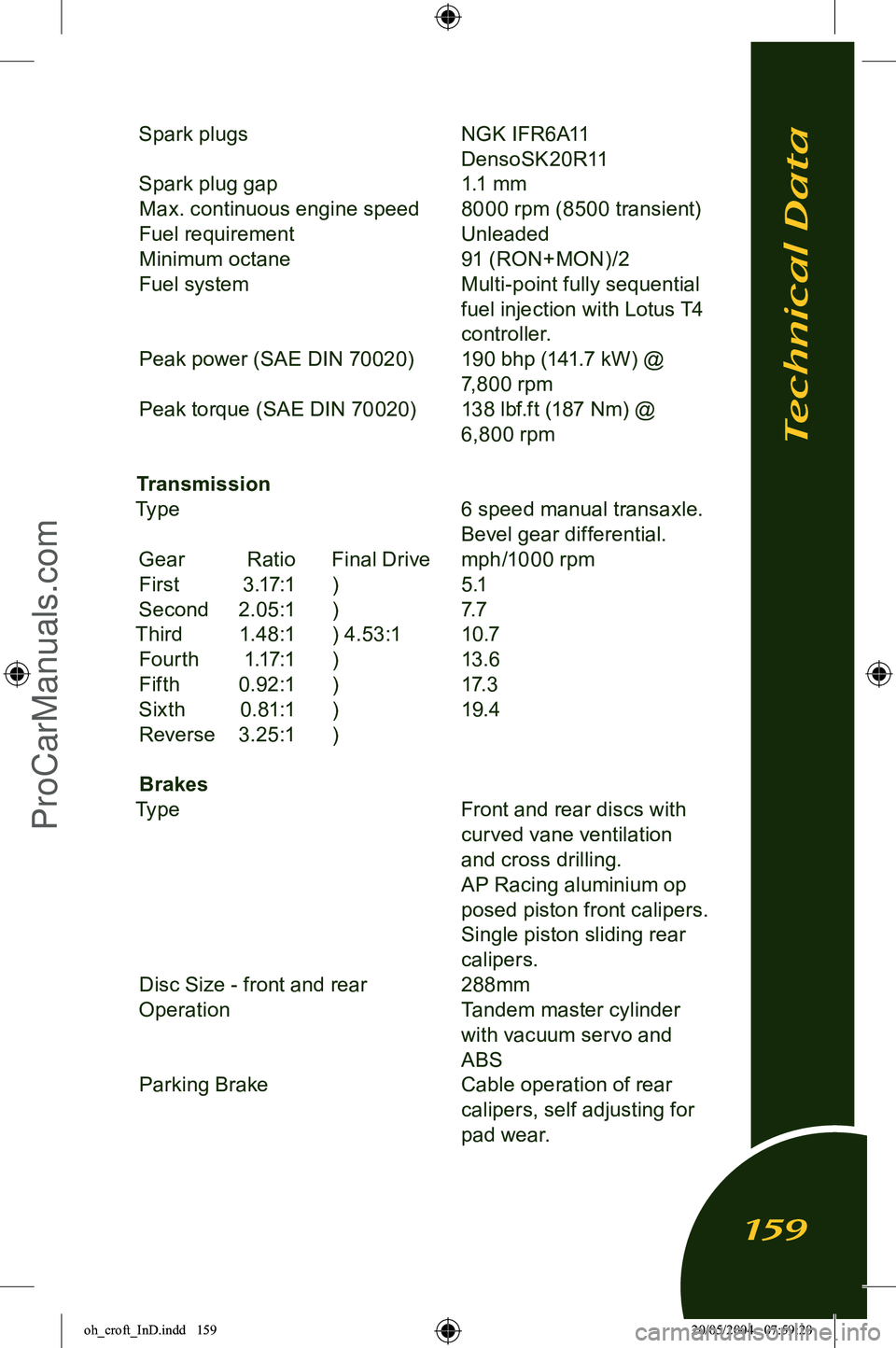
Spark plugs NGK IFR6A11
DensoSK20R11
Spark plug gap 1.1 mm
Max. continuous engine speed 8000 rpm (8500 transient)
Fuel requirement Unleaded
Minimum octane 91 (RON+MON)/2
Fuel system Multi-point fully sequential
fuel injection with Lotus T4
controller.
Peak power (SAE DIN 70020) 190 bhp (141.7 kW) @
7,800 rpm
Peak torque (SAE DIN 70020) 138 lbf.ft (187 Nm) @
6,800 rpm
Transmission
Type 6 speed manual transaxle.
Bevel gear differential.
Gear Ratio Final Drive mph/1000 rpm First 3.17:1 ) 5.1
Second 2.05:1 ) 7.7
Third 1.48:1 ) 4.53:1 10.7
Fourth 1.17:1 ) 13.6
Fifth 0.92:1 ) 17.3
Sixth 0.81:1 ) 19.4
Reverse 3.25:1 )
Brakes
Type Front and rear discs with
curved vane ventilation
and cross drilling.
AP Racing aluminium op
posed piston front calipers.
Single piston sliding rear
calipers.
Disc Size - front and rear 288mm
Operation Tandem master cylinder
with vacuum servo and
ABS
Parking Brake Cable operation of rear
calipers, self adjusting for
pad wear.
Technical Data
159
oh_croft_InD.indd 15920/05/2004 07:59:20ProCarManuals.com
Page 167 of 205
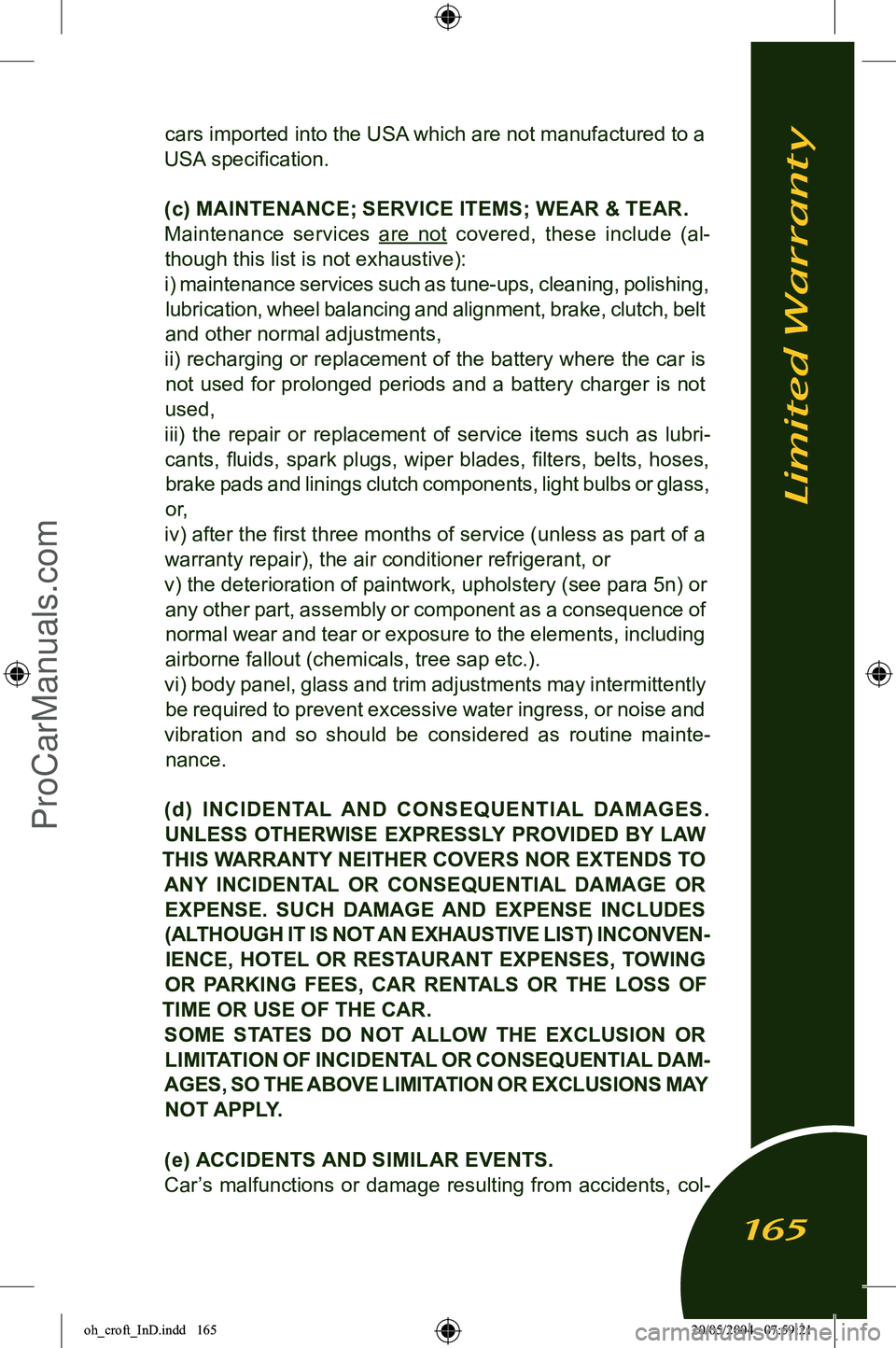
cars imported into the USA which are not manufactured to a
USA specification.
(c) MAINTENANCE; SERVICE ITEMS; WEAR & TEAR.
Maintenance services are not covered , these include (al-
though this list is not exhaustive):
i) maintenance services such as tune-ups, cleaning, polishing, lubrication, wheel balancing and alignment, brake, clutch, belt
and other normal adjustments,
ii) recharging or replacement of the battery where the car is not used for prolonged periods and a battery charger is not
used,
iii) the repair or replacement of service items such as lubri
-
cants, fluids, spark plugs, wiper blades, filters, belts, hoses, brake pads and linings clutch components, light bulbs or glass,
or,
iv) after the first three months of service (unless as part of a
warranty repair), the air conditioner refrigerant, or
v) the deterioration of paintwork, upholstery (see para 5n) or any other part, assembly or component as a consequence of
normal wear and tear or exposure to the elements, including
airborne fallout (chemicals, tree sap etc.).
vi) body panel, glass and trim adjustments may intermittently be required to prevent excessive water ingress, or noise and
vibration and so should be considered as routine mainte
-
nance.
(d) INCIDENTAL AND CONSEQUENTIAL DAMAGES. UNLESS OTHERWISE EXPRESSLY PROVIDED BY LAW
THIS WARRANTY NEITHER COVERS NOR EXTENDS TO ANY INCIDENTAL OR CONSEQUENTIAL DAMAGE OR EXPENSE. SUCH DAMAGE AND EXPENSE INCLUDES
(ALTHOUGH IT IS NOT AN EXHAUSTIVE LIST) INCONVEN
-
IENCE, HOTEL OR RESTAURANT EXPENSES, TOWING
OR PARKING FEES, CAR RENTALS OR THE LOSS OF
TIME OR USE OF THE CAR.
SOME STATES DO NOT ALLOW THE EXCLUSION OR LIMITATION OF INCIDENTAL OR CONSEQUENTIAL DAM
-
AGES, SO THE ABOVE LIMITATION OR EXCLUSIONS MAY NOT APPLY.
(e) ACCIDENTS AND SIMILAR EVENTS.
Car’s malfunctions or damage resulting from accidents, col-
Limited Warranty
165
oh_croft_InD.indd 16520/05/2004 07:59:21ProCarManuals.com
Page 180 of 205
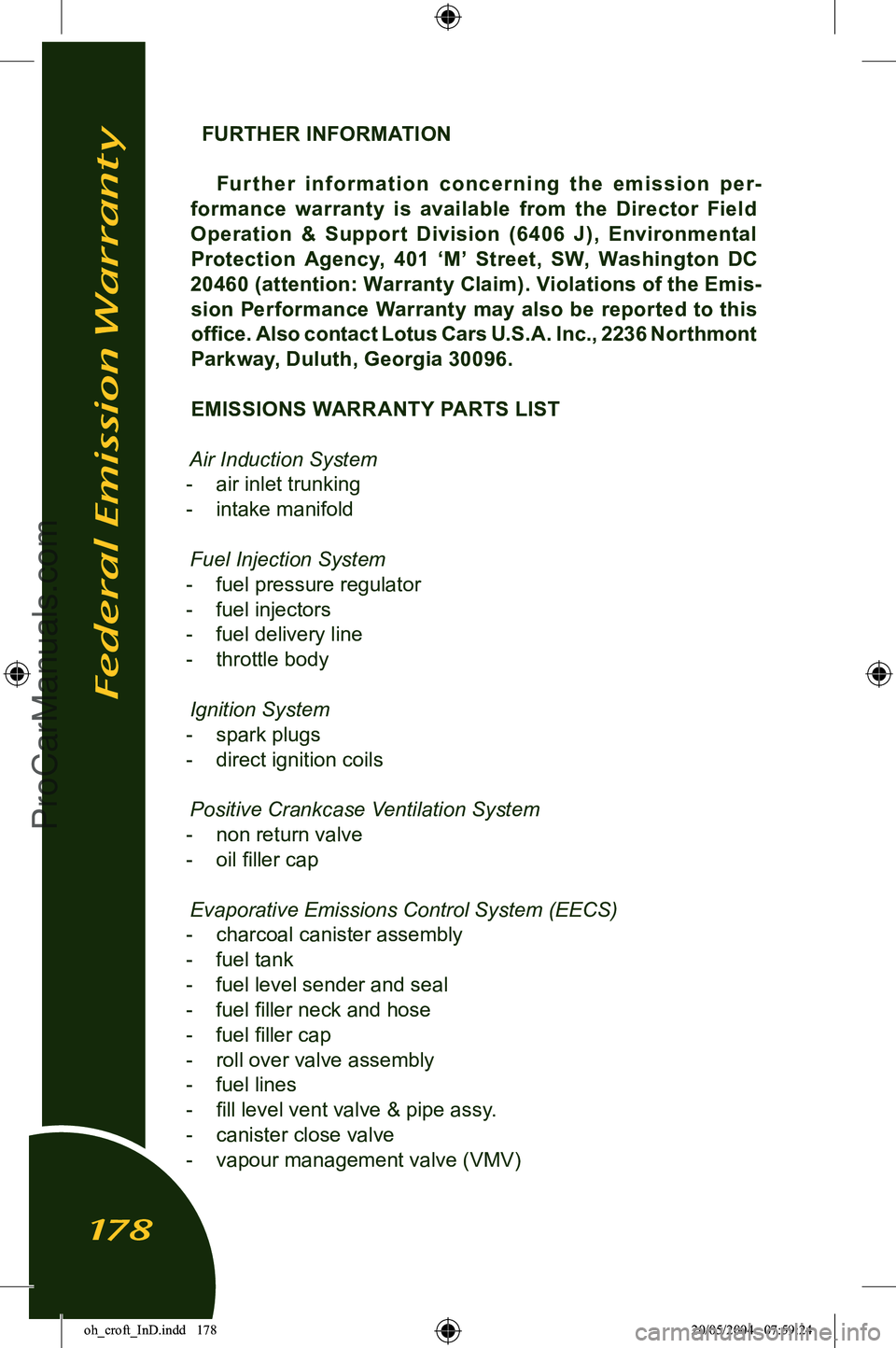
FURTHER INFORMATIONFu r t h e r i nf o r m a t i o n c o n c e r n i n g t h e e m i s si o n p e r
-
formance warranty is available from the Director Field Operation & Suppor t Division (6406 J), Environmental
Protection Agency, 401 ‘M’ Street, SW, Washington DC
20460 (attention: Warranty Claim). Violations of the Emis
-
sion Performance Warranty may also be reported to this
office. Also contact Lotus Cars U.S.A. Inc., 2236 Northmont
Parkway, Duluth, Georgia 30096.
EMISSIONS WARRANTY PARTS LIST
Air Induction System
- air inlet trunking
- intake manifold
Fuel Injection System
- fuel pressure regulator
- fuel injectors
- fuel delivery line
- throttle body
Ignition System
- spark plugs
- direct ignition coils
Positive Crankcase Ventilation System
- non return valve
- oil filler cap
Evaporative Emissions Control System (EECS)
- charcoal canister assembly
- fuel tank
- fuel level sender and seal
- fuel filler neck and hose
- fuel filler cap
- roll over valve assembly
- fuel lines
- fill level vent valve & pipe assy.
- canister close valve
- vapour management valve (VMV)
Federal Emission Warranty
178
oh_croft_InD.indd 17820/05/2004 07:59:24ProCarManuals.com